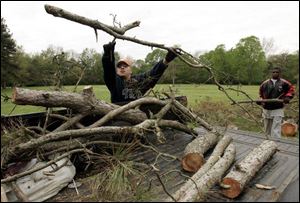
Hard work pays off victims
5/15/2005
Michael Garcia and Dominique Wiggins work at Side Cut Metropark. Mr. Garcia has almost paid his $322.85 restitution bill.
Thick callouses underneath Michael Garcia's brown work gloves offer the evidence: The work out here in Side Cut Metropark in Maumee is anything but easy.
Despite the sores and all his hard work, he never sees his twice-monthly paycheck: It goes to a man whose stolen car Mr. Garcia was riding in seven years ago.
Nevertheless, the 24-year-old Toledoan offers a friendly handshake and an easy smile when he talks of his job out here with the Lucas County Juvenile Court's restitution program.
"I'm glad this is almost over," he said, as he finished sliding another large pine branch into the rear of a pickup last week. "I've grown up, and it's time to get this all behind me."
Mr. Garcia is one of countless juveniles and young adults who have cut down trees, hauled mulch, built fences, and painted picnic tables and park benches after being ordered by Lucas County Juvenile Court judges to pay restitution for crimes that range from criminal damage to assaults to sex crimes.
The program, one of the nation's longest-running, recently passed a stunning benchmark, according to those who work most closely with the often-reluctant youths. In March, the program paid out its $3 millionth dollar to a crime victim.
That's $3 million victims otherwise might not have seen, said Joe Schwartz, head of the seven-person restitution staff at the juvenile court building in downtown Toledo.
Additionally, almost every dollar of it has been earned at minimum wage, which was just $2.20 an hour when the program began in 1976 and now is $5.15 an hour.
"That's a lot of work from a lot of kids over a lot of hours," Mr. Schwartz said.
The payroll comes from the Ohio Department of Youth Services. Counties can tap into the pot either to lock up troubled juveniles or provide services for them. In this case, local officials tally the hours a juvenile has worked every two weeks, and submit the paperwork to have a paycheck cut directly to the crime victim from the funds.
The program began under former Lucas County Juvenile Court Judge Andy Devine. Sometimes, as in the case with Mr. Garcia, it takes years to pay off a debt, Mr. Schwartz said.
"We'd realized you can preach the gospel and scream and holler, but until kids see the consequences, it doesn't hit home," Judge Devine said.
It was a cutting-edge idea in the 1970s, because the nation's courts for years had treated juveniles as either misunderstood youths, monstrous anomalies, or even medical mysteries, said Doug Thompson, researcher at the National Center for Juvenile Justice in Pittsburgh.
Over time, the court began to stress "restorative justice," a policy that balances community safety, appropriate penalties, and accountability to crime victims, Mr. Thompson said.
Gordon Bazemore, a professor of criminology and criminal justice at Florida Atlantic University, began assessing juvenile restitution programs in the 1970s and continues to do so today. Initial research indicated that 88 percent of juveniles successfully finished paying restitution in some of the nation's earliest programs and many courts began adopting such plans in the 1980s, he said.
But over time, the programs have fallen victim to budget cuts and shifting court priorities. Only those like Lucas County's - those with structure and staff commitment - have survived and been successful, he said.
"Kids can do it, but the problem is that in many places it's just not a priority," Mr. Baze-
more said. "People don't see the value of it. Most probation officers say they don't want to be bill collectors."
In fact, even Lucas County's program appears to be a losing proposition if you measure it dollar-for-dollar. Last year, the program closed restitution in criminal cases that amounted to $181,833. Some was paid by defendants who had other jobs at restaurants or other businesses. About $140,893 came from state funds earned by defendants working off their tab.
Yet paying salaries and benefits for the restitution program's staff cost Lucas County more than $322,000.
Still, Mr. Schwartz said about nine of the ten defendants ordered to pay restitution eventually pay their bill in full.
"Now, that's not saying it's successful in three months, and it's not saying it's successful in six months," he said. "But we don't give up. We are successful."
When defendants don't show up for work, a judge can issue an arrest warrant.
Mr. Garcia learned that the hard way. He began working at paying back a $322.85 restitution bill for the 1998 joy ride years ago. But since then, he'd moved, become a father, and got engaged, he said. Still, he owed $177.85, so when he recently was cited for a traffic violation, a warrant for his arrest forced the 24-year-old back into juvenile court.
Supervisor Bill Hillabrand smiled widely last week, watching Mr. Garcia and Dominique Wiggins, 14, fight unruly pine branches bound for a mulching pile. The two have become some of his hardest workers, he said.
Mr. Hillabrand said they best exemplify those things that can't be quantified in a cost-benefits analysis of the program: the job skills they've gained, the time they've spent sprucing up the park instead of getting into trouble, or the service they've provided to the community.
"Those are things you can't count, but in a lot of ways, those are the most important things," he said. "This is about accountability, and hard work will teach you that real fast."
Contact Robin Erb at: robinerb@theblade.com or 419-724-6133.